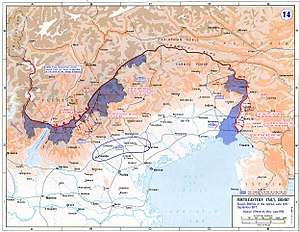Fourth Battle of the Isonzo
The Fourth Battle of the Isonzo was fought between the armies of Kingdom of Italy and those of Austria-Hungary on the Italian Front in World War I, between November 10 and December 2, 1915.
| Fourth Battle of the Isonzo | |||||||
|---|---|---|---|---|---|---|---|
| Part of the Italian Front (World War I) | |||||||
 Eleven Battles of the Isonzo June 1915 – September 1917 | |||||||
| |||||||
| Belligerents | |||||||
|
|
| ||||||
| Commanders and leaders | |||||||
|
|
| ||||||
| Strength | |||||||
|
370 battalions 1,374 guns |
155 battalions 626 guns | ||||||
| Casualties and losses | |||||||
| 49,500 (7,500 dead) | 32,100 (4,000 dead) | ||||||
Overview
In contrast to the previous three Battles of the Isonzo (June, July and October), this offensive lasted a short amount of time, and is sometimes considered a continuation of the previous offensive.
Most of the clash was concentrated in the direction of Gorizia and on the Kras Plateau, though the push was distributed on the whole Isonzo front. The Italian Second Army, aiming for the town of Gorizia, was able to capture the hilly area around Oslavia and San Floriano del Collio overlooking the Soča (Isonzo) and Gorizia itself. The Italian Third Army, covering the rest of the front up to the sea, launched a series of large and bloody attacks which brought no significant gain.
Mount Sei Busi, already the scene of bitter fighting, was attacked five times by the Italian forces, always in vain.
The intensity of the fighting increased until the end of November, when the bridgehead of Tolmin (Italian: Tolmino) was heavily bombed by both sides and the casualty ratio per day reached its apex. In the first fifteen days of December, however, the fighting was reduced to small scale skirmishes as opposed to the massive frontal assaults that characterized the previous phases of the battle.
An unsigned truce arrived together with the first great cold in the mountains of the Kras, and operations were ceased due to lack of supplies.
The Austro-Hungarian High Command, worried by the huge losses, requested assistance from the German Empire, which was not yet formally in the war against Italy. This would eventually lead to German intervention on the Italian front starting with the Eleventh Battle of the Isonzo.
See also
References
- Tommasi, Giuseppe (1925). Brigata Sassari. Note di guerra (PDF). Rome: Tipografia sociale. p. 58.
Further reading
- Macdonald, John, and Željko Cimprič. Caporetto and the Isonzo Campaign: The Italian Front, 1915-1918. Barnsley, South Yorkshire: Pen & Sword Military, 2011. ISBN 9781848846715 OCLC 774957786
- Schindler, John R. (2001). Isonzo: The Forgotten Sacrifice of the Great War. Praeger. ISBN 0275972046. OCLC 44681903.
External links
- FirstWorldWar.Com: The Battles of the Isonzo, 1915-17
- Battlefield Maps: Italian Front
- 11 battles at the Isonzo
- The Walks of Peace in the Soča Region Foundation. The Foundation preserves, restores and presents the historical and cultural heritage of the First World War in the area of the Isonzo Front for the study, tourist and educational purposes.
- The Kobarid Museum (in English)
- Društvo Soška Fronta (in Slovenian)
- Pro Hereditate - extensive site (in En/It/Sl)